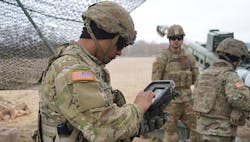IS4S to use open-systems standards like SOSA for battlefield positioning, navigation, and timing (PNT)
ABERDEEN PROVING GROUND, Md. – U.S. Army positioning, navigation, and timing (PNT) experts needed a company to develop plug-and-play open-architecture designs for battlefield PNT. They found a solution from Integration Solutions For Systems (IS4S) Inc. in Huntsville, Ala.
Officials of the Army Contracting Command at Aberdeen Proving Ground, Md., announced a $9.5 million three-year contract to IS4S on Tuesday for the Positioning, Navigation And Timing project, which seeks to develop battlefield technologies in PNT.
The Army Contracting Command awarded the contract on behalf of the Army Combat Capabilities Development Command (CCDC) Command, Control, Communications, Computers, Combat Systems, Intelligence, Surveillance and Reconnaissance (C5ISR) office at Aberdeen Proving Ground.
The project as extensively as possible will make use of open-systems standards such as Vehicular Integration for C4ISR/EW Interoperability (VICTORY); Modular Open RF Architecture (MORA); OpenVPX; REDHAWK software-defined radio (SDR) framework; Software Communications Architecture (SCA); Future Airborne Capability Environment (FACE); and Sensor Open Systems Architecture (SOSA), Army officials say.
Related: SOSA and open standards for military embedded computing
The project seeks to discover technical approaches to improve land warrior capabilities by enabling the soldier to operate in hostile RF- and GPS-denied environments in urban fighting. This will involve using open interfaces to connect electronic modules to adapt systems, integrate new capabilities, and share information rapidly from machine to machine.
In their work, IS4S engineers will rely on the SOSA and CMOSS open-systems standards whenever possible, Army officials say.
This project revolves around 10 topics: vehicle navigation systems (VNS); inertial navigation; positioning; aiding sensors for navigation systems; navigation sensor fusion; biomimetics for navigation; timing for PNT systems; modeling and simulation for PNT; technologies for navigation warfare; and autonomy and artificial intelligence (AI) for PNT. Several contracts will be awarded, so additional contractors have yet to be named.
Vehicle navigation systems will develop ground vehicle-mounted PNT systems for battlefield command and decision making. This will involve enabling manned and unmanned vehicles to operate in GPS-challenged and -denied environments using small size, weight, power, and cost (SWaP-C) packaging; interfaces for encryption keying, user interface or display; and connectors for external power, antenna, and electrical interfaces like Ethernet that can route PNT data.
Related: SOSA standard taking hold in military embedded computing
Inertial navigation involves improved situational awareness in GPS-denied conditions, including gyroscope and accelerometer sensor designs that use micro-electro-mechanical systems (MEMS), as well as mechanical, optical, and atomic domains.
Positioning will develop location and orientation technologies such as advanced GPS receiver hardware; new RF front end designs; non-traditional RF correlator configurations; antennas, software-defined GPS receivers; and GPS signal integrity monitoring.
Aiding sensors for navigation systems will develop navigation-aiding technologies for operations where GPS performance is degraded or unavailable, including improved situational awareness and decision-making.
Navigation sensor fusion seeks to develop open-architecture sensor fusion for navigation-aiding sensors like cameras, magnetometers, and laser rangefinders; plug-and-play architectures with standardized software and electrical and mechanical interfaces; compressive sensing algorithms; and AI and sensor fusion.
Biomimetics for navigation seeks to develop biologically inspired sensors for attitude, orientation and navigation; synergistic fusion of biomimetic and traditional PNT technologies; and SWaP-C of biologically inspired PNT systems. Biomimetics applies principles from engineering, chemistry, and biology to machines that mimic biological processes.
Timing for PNT systems seeks to develop timing sources and time transfer technologies for command and decision-making such as accuracy, long- and short-term stability, and low-phase noise. Of interest are miniature atomic clocks, atomic frequency standards, and tightly coupled GPS receivers and clocks.
Modeling and simulation for PNT in designing trade-offs in technology development; analyzing PNT technology insertion, mission planning and decision making. and PNT technology development.
Technologies for navigation warfare involves technologies to enable U.S. Forces to deny GPS and GNSS to adversaries while simultaneously enabling U.S. Forces to survive an electronic attack against GPS. This will involve techniques in real-time detection, geo-location and characterization of GPS interference sources; real-time detection of GPS receiver spoofing; situational awareness using GPS receivers and sensors integrated into Army units; technologies that assure unimpeded access to precise navigation information in challenging environments; and technologies that selectively deny PNT information to adversaries while protecting PNT information to neutral and friendly forces.
Autonomy and AI for PNT seeks to develop AI for vehicle navigation; inertial navigation; positioning; aiding sensors for navigation systems; navigation sensor fusion; biomimetics for navigation; timing for PNT systems; modeling and simulation for PNT; and technologies for navigation warfare.
On this contract IS4S will do the work at locations to be determined with each order, and should be finished by March 2026. For more information contact IS4S online at www.is4s.com; the Army Contracting Command-Aberdeen at https://acc.army.mil/contractingcenters/acc-apg/; or the Army CCDC C5ISR at https://c5isr.ccdc.army.mil.
About the Author
John Keller
Editor-in-Chief
John Keller is the Editor-in-Chief, Military & Aerospace Electronics Magazine--provides extensive coverage and analysis of enabling electronics and optoelectronic technologies in military, space and commercial aviation applications. John has been a member of the Military & Aerospace Electronics staff since 1989 and chief editor since 1995.

